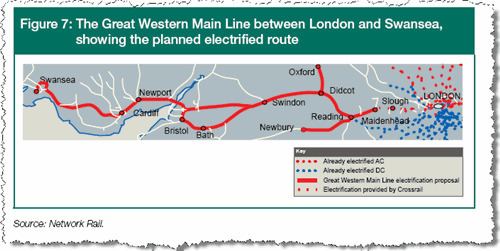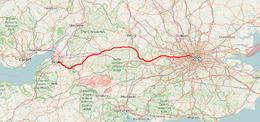Stations 25 | Status Operational | |
 | ||
Locale Greater LondonSouth East EnglandSouth West England Opened 30 June 1841 (complete line) Depots | ||
Iep test train run on great western main line
The Great Western Main Line is a main line railway in Great Britain, that runs westwards from London's Paddington station to Bristol Temple Meads. It was the original route of the pre-1948 Great Western Railway which was merged into the Western Region of British Railways and is now a part of the national rail system managed by Network Rail.
Contents
- Iep test train run on great western main line
- History
- Heritage
- Route
- Services
- Infrastructure
- Planned developments
- Electrification west of Airport Junction
- Other proposals
- Calls for station reopenings
- Major incidents
- References

The line is currently being electrified. It was electrified from Paddington to Heathrow Airport in the late 1990s. Work to electrify the remainder of the route started in 2011 with an initial aim to complete the work all the way to Bristol by 2016. The programme however has been deferred for six years with no end completion forecast because costs have tripled. The four sections that are delayed are: Oxford to Didcot Parkway, Bristol Parkway to Bristol Temple Meads, Bath Spa to Bristol Temple Meads and the Thames Valley branches to Henley and Windsor.

History
The line was built by the Great Western Railway and engineered by Isambard Kingdom Brunel as a dual track line using a wider 7 ft (2,134 mm) broad gauge and was opened in stages between 1838 and 1840. The alignment was so level and straight it was nicknamed ‘Brunel’s Billiard Table’. It was supplemented with a third rail for dual gauge operation allowing standard gauge 4 ft 8 1⁄2 in (1,435 mm) trains to also operate on the route in stages between 1854 and 1875. Dual gauge was introduced as follows: London to Reading (October 1861), Reading to Didcot (December 1856), Didcot to Swindon (February 1872), Swindon to Thingley Junction, Chippenham (June 1874), Thingley Junction to Bathampton (March 1875), Bathampton to Bristol (June 1874), Bristol station area (May 1854). The broad gauge remained in use until 1892. Evidence of the original broad gauge can still be seen at many places where bridges are a wider than usual, or where tracks are ten feet apart instead of the usual six.

The original dual tracks were widened to four track in various places between 1877 and 1899. Paddington to Southall (October 1877), Southall to West Drayton (November 1878), West Drayton to Slough (June 1879), Slough to east side of Maidenhead Bridge (September 1884), Maidenhead Bridge to Reading (June 1893), Reading station (1899), Reading to Pangbourne (July 1893), Pangbourne to Cholsey and Moulsford (?), Cholsey and Moulsford to Didcot (December 1892), various short sections between Didcot and Swindon, and at Bristol.

Following the Slough rail accident in 1900 when five passengers were killed, improved vacuum braking systems were used on locomotives and passenger rolling stock and Automatic Train Control (ATC) was introduced in 1908.
Further widenings of the line took place between 1903 and 1910.

At the outbreak of World War I in 1914, the Great Western Railway was taken into government control, as were most major railways in Britain and were reorganised after the war into the "big four" companies, of which the Great Western Railway was one. The railways returned to direct government control during World War II before being nationalised to form British Railways in 1948.
More widening infrastructure work took place between 1931 and 1932, and the extension to south wales was quadrupled 1941.
The line speed was upgraded in the 1970s to support the introduction of the InterCity 125 (HST).
In 1977 the Parliamentary Select Committee on Nationalised Industries recommended considering electrification of more of Britain's rail network, and by 1979 BR presented a range of options that included electrifying the GW Main Line from Paddington to Swansea by 2000. Under the 1979–90 Conservative governments that succeeded the 1976–79 Labour government the proposal was not implemented.
In August 2008 it was announced that a number of speed limits on the relief lines between Reading and London have been raised so that 86% of the line can be used at 90 miles per hour (140 km/h), however the time allowed between stations for trains running on the relief lines has been reduced in the December 2008 timetable to improve timekeeping.
Heritage
The route of the GWML includes dozens of listed buildings and structures, including tunnel portals, bridges and viaducts, stations, and associated hotels. Part of the route passes through and contributes to the Georgian Architecture of the City of Bath World Heritage Site - the path through Sydney Gardens has been described as a "piece of deliberate railway theatre by Brunel without parallel". Grade I listed structures on the line include London Paddington, Wharncliffe Viaduct, the 1839 Tudor gothic River Avon Bridge in Bristol, and Bristol Temple Meads Station.
Route
The communities served by the Great Western Main Line include: West London (including Acton, Ealing, Hanwell, Southall, Hayes, Harlington and West Drayton); Iver; Langley; Slough; Burnham; Taplow; Maidenhead; Twyford; Reading; Tilehurst; Pangbourne; Goring-on-Thames; Streatley; Cholsey; Didcot; Swindon; Chippenham; Bath; Keynsham; and Bristol.
From London to Didcot, the line follows the Thames Valley, crossing the River Thames three times, including on the famous Maidenhead Railway Bridge. After Swindon, trains pass the Swindon Steam Railway Museum. From Wootton Bassett there are two different routes to Bristol, firstly via Box Tunnel and secondly via Bristol Parkway.
It is also possible to run via the Wessex Main Line, but this involves a reversal at Bradford Junction, so is only really suitable for multiple unit trains or via Reading to Bath via Newbury. Trains on the Great Western Main Line are sometimes diverted from Reading along the Reading to Taunton line, as far as Westbury, from where they can use the Wessex Main Line to reach either Chippenham, or Bath Spa. Beyond Bristol, some trains continue on the Bristol to Taunton Line to Weston-super-Mare or beyond.
The following routes are managed by Network Rail as part of the Great Western Main Line (Route 13): Didcot to Oxford and Worcester via the Cherwell Valley Line and Cotswold Line, Swindon to Cheltenham Spa via the Golden Valley Line, Swindon to Cardiff Central and Swansea via the South Wales Main Line, Cross Country Routes south of Birmingham and also all connecting branch lines.
Services
Main line and local services are provided by Great Western Railway (GWR). The stations served by trains between London Paddington and Bristol Temple Meads are: Slough, Reading, Didcot Parkway, Swindon, Chippenham, and Bath Spa. Not all trains between London and Bristol call at Slough, Didcot, Chippenham, and Bath Spa
Fast trains from Paddington to London Heathrow Airport are operated by Heathrow Airport Holdings as the Heathrow Express. Local services on this route are jointly operated by GWR and BAA under the Heathrow Connect name.
CrossCountry operate trains between Reading and Oxford, using the Great Western Main Line as far as Didcot and South West Trains operate a limited number of trains between Bath and Bristol.
Great Western Railway also operate a train between London Paddington – Cardiff Central every 30 minutes, with hourly extensions to Swansea. At Swansea/Cardiff there is a connecting Arriva Trains Wales boat train to/from Fishguard Harbour for the Stena Line ferry to Rosslare Europort in Ireland. An integrated timetable is offered between London Paddington and Rosslare Europort with through ticketing available. Daytime and nocturnal journeys are offered in both directions daily (including Sundays). Additionally, 2–3 Great Western Railway trains continue to Pembroke Dock on weekends during the Summer season to connect with ferry services to Ireland.
Infrastructure
Between London and Didcot there are four tracks, two for each direction. The main lines are mostly used by the faster trains and are on the south side of the route. The relief lines on the north side are used for slower services and those that need to call at all stations as only London Paddington, Slough, Maidenhead, Twyford, Reading and Didcot Parkway stations have platforms on the main lines (although a few others have main line platforms that can be used in an emergency). Between Didcot and Royal Wootton Bassett there are a series of passing loops lines to allow fast trains to overtake slower ones. This section is also signalled for bi-directional running on each line but this facility is usually only used during engineering working or when there is significant disruption to traffic in one direction.
The line electrified for 12 miles using 25 kV AC overhead supply lines between Paddington and Airport Junction (the junction with the line to London Heathrow Airport west of Hayes & Harlington).
The line speed is 125 miles per hour (201 km/h). The relief lines from Paddington to Didcot are limited to 90 miles per hour (140 km/h) as far as Reading, and then 100 miles per hour (160 km/h) to Didcot. Lower restrictions apply at various locations. The line is one of two Network Rail-owned lines equipped with the Automatic Train Protection (ATP) system, the other being the Chiltern Main Line.
Planned developments
Since 2011, the Great Western has been undergoing a £5 billion modernisation by Network Rail.
Reading railway station saw a major redevelopment with new platforms, a new entrance, footbridge and lifts; the work was completed a year ahead of schedule in July 2014.
Electrification west of Airport Junction
As part of Crossrail the Great Western was already planned to be electrified from Airport Junction to Maidenhead but, following a number of announcements and delays, the government announced in March 2011 that the line would be electrified between London and Cardiff together with the section linking Bristol Parkway and Bristol Temple Meads. In July 2012, the government announced that the final portion of the Great Western, from Cardiff to Swansea, would be electrified.
In addition to allowing Crossrail services with the new Class 345 EMUs, the electrification will also accommodate Great Western Railway's Class 387 EMUs. It was originally planned to bring second-hand units from Thameslink and Great Northern after the arrival of their new Class 700 trains but it was later decided to order new Class 387s for GWR instead. Eight were delivered during 2016, with more on order to bring the total to 45. The Class 165 and Class 166 DMUs currently used by GWR for Thames Valley services will be displaced to services on the lines around Cardiff and Bristol, and the coastal routes around Devon and Cornwall, to replace ageing Class 143 Pacers and Class 150 / 153 Sprinters built in the 1980s.
The line will also be used by the new Hitachi Super Express high speed trains – the Class 800s, 801s and 802s – which will gradually replace the InterCity 125 and Class 180 sets currently used for the long-distance services.
Other proposals
Network Rail plans to install European Rail Traffic Management System (ERTMS) in-cab signalling on the Great Western line; this is a pre-requisite for the Super Express trains to run at 140 mph (225 km/h). Some or all of the resignalling work will be undertaken during the electrification work.
Further capacity improvements are also scheduled at Swindon, adding to recent changes and the new Platform 4.
Crossrail services are planned to terminate at Reading. Some of the current suburban services into London Paddington are planned to be transferred to the new Crossrail service, which will in turn free up some surface-level capacity at London Paddington.
Other more distant aspirations include resignalling and capacity improvements at Reading; the provision of four continuous tracks between Didcot and Swindon (including a grade-separated junction at Milton, where westbound relief line switches from the north side of the line to the south); and resignalling between Bath and Bristol to enable trains to run closer together.
Access to Heathrow Airport from the west remains an aspiration and the 2009 Heathrow Airtrack scheme, abandoned in 2011, proposed a route south of the Great Western Main Line to link the airport with Reading. Plans for electrification of the line will make it easier to access Heathrow from Reading, since lack of electrification between Reading station and Airport Junction (near West Drayton station) was a limiting factor. Plans under consideration in 2014 included new tunnels between Heathrow and Langley.
Network Rail intends to replace the ATP system with ETCS – Level 2 from 2017 to 2035 along with the introduction of the new IEP trains.
Signalling Solutions is to resignal the 12 miles from Paddington to West Drayton, including the Airport branch, as part of the Crossrail project.
Calls for station reopenings
There are calls for the reintroduction of a station at Corsham due to recent growth of the town. The original station was closed to passengers in 1965.
A local group is campaigning for the reopening of Saltford station between Bath and Bristol, to coincide with electrification.
There have also been calls to reopen the former Wantage Road station. Oxfordshire County Council include a proposal for a new station to serve for Wantage and Grove in their 2015-2031 local transport plan.
